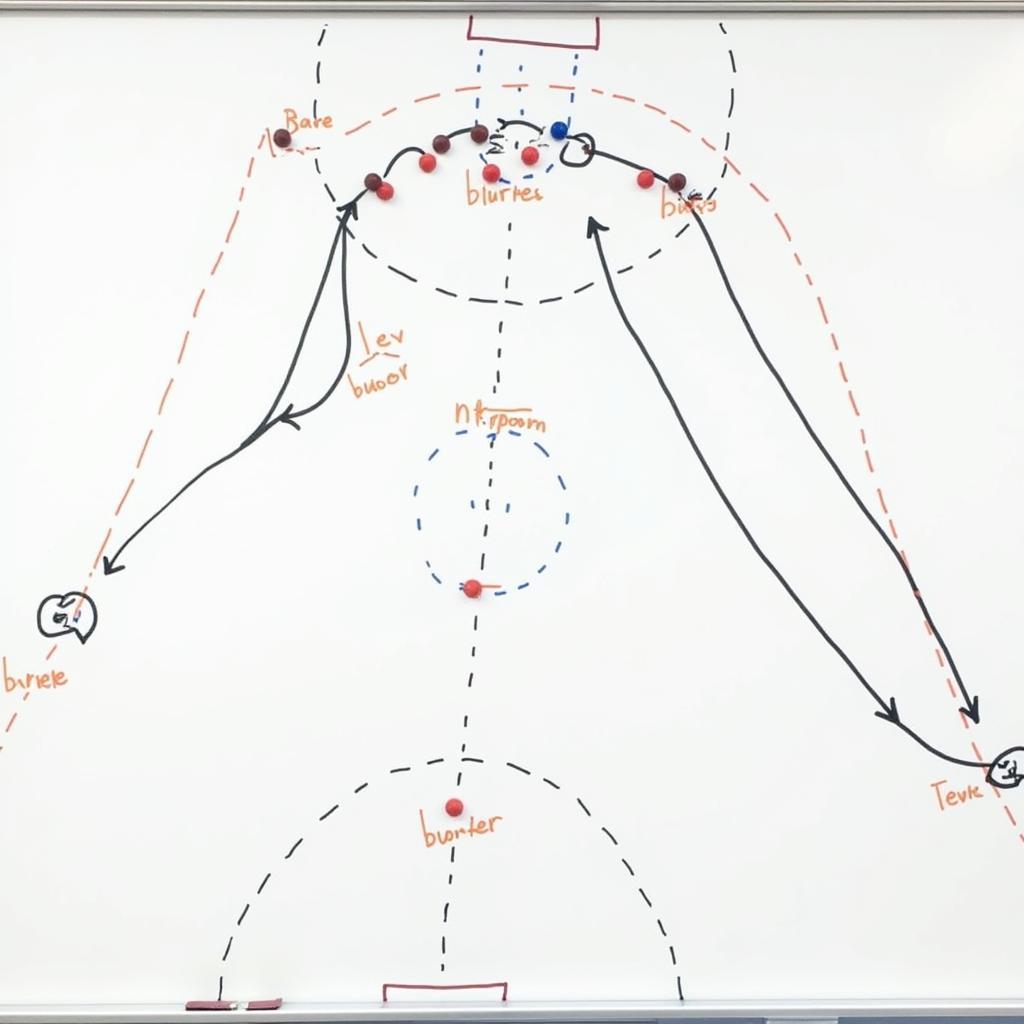The Football Whiteboard: a blank canvas of endless possibilities, a coach’s secret weapon, and a tool that can transform a team’s performance on the field. Whether you’re a seasoned veteran or just starting your coaching journey, understanding how to effectively utilize a football whiteboard is crucial for success. This comprehensive guide will delve into the intricacies of this powerful tool, equipping you with the knowledge and strategies to elevate your coaching game.
Why the Football Whiteboard Matters
Before we dive into the specifics, let’s address the elephant in the room: why is the humble whiteboard so important in the digital age?
In an era dominated by sophisticated software and high-tech gadgets, the simplicity of a whiteboard might seem archaic. However, its beauty lies in its simplicity. It offers a tangible, visual medium to convey complex ideas, fostering clear communication and understanding amongst players.
 Football coach explaining strategy on whiteboard
Football coach explaining strategy on whiteboard
Essential Elements of Football Whiteboard Strategy
Effectively utilizing a football whiteboard isn’t just about scribbling down plays; it’s about creating a visual language that resonates with your players. Here’s how to make the most of it:
1. Know Your Canvas: Types of Football Whiteboards
Football whiteboards come in various shapes, sizes, and formats. Choose one that aligns with your coaching style and needs.
- Traditional Whiteboard: The classic option, ideal for brainstorming and illustrating plays.
- Magnetic Whiteboard: Allows you to use magnets to represent players, adding an interactive element.
- Roll-Up Whiteboard: Perfect for coaches on the go, offering portability and easy storage.
2. Speak the Language: Standard Football Symbols and Notations
Just like any language, football has its own set of symbols and notations used on whiteboards. Familiarize yourself with these universal symbols to ensure clarity and avoid confusion.
Pro Tip: Create a legend on your whiteboard explaining the symbols to new players.
3. Breaking it Down: Effective Play Diagramming
A well-structured play diagram is the heart of whiteboard strategy. Here’s how to make yours stand out:
- Clear and Concise: Keep it simple. Use lines, arrows, and symbols to represent player movement and avoid unnecessary clutter.
- Color Coding: Utilize different colored markers to differentiate between offensive and defensive players, routes, and assignments.
- Offensive and Defensive Perspectives: Show both offensive and defensive formations to provide a holistic view of the play.
 Diagram of a football offensive play on a whiteboard
Diagram of a football offensive play on a whiteboard
Beyond the Basics: Advanced Whiteboard Techniques
Once you’ve mastered the fundamentals, elevate your whiteboard game with these advanced techniques:
1. Film Study Integration: Analyzing Opponents
Use the whiteboard in conjunction with game film to dissect opponents’ tendencies, formations, and weaknesses.
Example: Highlight areas of vulnerability in the opponent’s defense and brainstorm plays that exploit those weaknesses.
2. Interactive Drills: Engaging Players Actively
Transform your whiteboard sessions into interactive drills by involving players in the process.
Example: Have players come up to the whiteboard and draw their understanding of a play or defensive assignment.
3. Adapting to Different Learning Styles: Visual, Auditory, Kinesthetic
Recognize that players learn differently. Incorporate various methods to cater to visual, auditory, and kinesthetic learners.
Example: Use a combination of diagrams, verbal explanations, and physical demonstrations to explain a concept.
The Power of Visual Communication: Real-world Applications
A well-executed whiteboard strategy transcends the practice field. It has real-world applications that directly impact game-day performance.
1. Half-Time Adjustments: Turning the Tide
Half-time is crucial for making adjustments based on the first-half performance. Use the whiteboard to:
- Illustrate opponent tendencies observed during the game.
- Make changes to the game plan based on the opponent’s strategy.
- Reinforce key concepts and motivate players for the second half.
2. In-Game Communication: On-field Clarity
While not always feasible during a game, the whiteboard can be used for quick sideline adjustments and play calls.
Example: Use a smaller, portable whiteboard to communicate plays or defensive adjustments to players coming off the field.
Conclusion: The Enduring Legacy of the Football Whiteboard
In the ever-evolving world of football, the whiteboard remains a timeless tool for coaches. Its ability to simplify complex concepts, foster communication, and enhance player understanding is unparalleled. By embracing the strategies outlined in this guide, you can unlock the full potential of the football whiteboard and elevate your coaching to new heights. Remember, the whiteboard is more than just a surface; it’s a blank canvas for innovation, strategy, and ultimately, success on the football field.
Need help refining your coaching strategies? Contact us at 0902476650 or email us at [email protected]. You can also visit our office at 139 Đ. Võ Văn Kiệt, Hoà Long, Bà Rịa, Bà Rịa – Vũng Tàu, Việt Nam. Our team of experts is available 24/7 to assist you!





